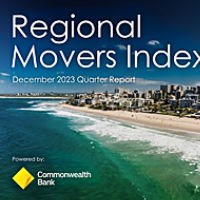Data from the just-released March 2024 quarter RMI shows internal migration across the nation has soared in the first three months of the year, with the regions recording their fifth biggest quarter of influx from city-slickers in the last six years.
Regional Australia Institute (RAI) CEO Liz Ritchie said the figures show the nation’s regional renaissance is far from over, with 24 per cent more people moving from the city to regions, than the other direction.
“People are voting with their feet and making a very conscious decision to live in regional Australia. Whilst the pandemic supercharged this movement, the regional lifestyle is continuing to prove highly desirable for thousands of people, especially those from cities,” Ms Ritchie said.
“This movement in population can no longer be seen as a quirky flow-on affect from the lockdown years. A societal shift is underway. This sustained trend provides tangible evidence regarding the importance of investing in and supporting the regions, to ensure communities have the services, skills, and infrastructure they need for their growing populations.”
New analysis in this quarter’s RMI has shone a light on the demographics of these city movers, as well as where they were based and where they’ve moved to.
Commonwealth Bank’s Regional and Agribusiness Executive General Manager, Paul Fowler, said in all seven capital cities analysed, millennials (born between 1981 and 1995) were the demographic most on the move, with the Gold Coast emerging as a firm favourite across the nation.
“This quarter’s report paints the picture of younger individuals or younger families looking for somewhere that's more affordable. Many are opting for the large regional centres which are buzzing with business activity and investment, offering a great range of employment opportunities,” Mr Fowler said.
Ms Ritchie said there was also a clear trend emerging regarding where metro movers were originally living, and where they’d chosen to relocate to.
“With high house prices and cost-of-living pressures biting, many people are realising the regions can offer the lifestyle they want and the jobs they’re after, minus big city problems – like long commute times, tolls and traffic,” Ms Ritchie said.
“People living in ‘commuter belts’, on the outskirts of major metropolitan cities, are relocating within a few years of moving there. Often, they’re leaving the outer suburbs for big regional centres like the Gold Coast, Sunshine Coast, Wollongong, Newcastle, Geelong, Busselton, the Alexandrina region, and Launceston.”
The Sunshine Coast held onto its title of the nation’s most popular destination for Australian movers, securing a 16 per cent share of net internal migration flows over the last 12 months, while Sydney continues to be the nation’s biggest shedder of people, accounting for 67 per cent of net capital city outflows to the regions over the year to March 2024.
Further analysis also shows in the last year, regional New South Wales, Queensland, and Victoria accounted for 97 per cent of net capital outflows, up from 94 per cent in the year prior.
Mr Fowler noted in the 12 months to March 2024, areas within a 150km radius of a capital were among the most popular for metro-leaving movers.
“The Sunshine Coast topped the list for the fifth consecutive quarter with an 11.8 per cent share of net capital to regional migration, while the Gold Coast came in second place – with the highest quarterly growth rate of the top five – followed by Moorabool (Vic), Lake Macquarie (NSW) and Greater Geelong (Vic),” Mr Fowler said.
Western Australia also shaped up as an increasingly attractive destination with Capel, Greater Geraldton, Northam and Albany all making their way onto various hotspot lists this quarter.
“Regional LGAs on, or near, the sea were found to be this quarter’s top five growth regional hotspots, with Capel in the south-west of Western Australia making its debut in the top five with a near five-fold increase in net internal migration inflows on the back of its popularity amongst regional movers. What this shows us is many Australians are still seizing their sea change dreams,” commented Mr Fowler.
The Inter-Regional Migration Index, which tracks regional to regional relocations, also rose in the March 2024 quarter, to see it hit its third highest level in six years.
Access the latest Regional Movers Index March quarter.
The RAI’s Regions Rising National Summit - The New Frontier, will be held from Tuesday 13 August to Thursday 15 August at the National Convention Centre in Canberra.
Get further information or register for the event.
Editor’s note
The Regional Movers Index, launched in 2021, tracks movements between Australia’s regions and capital cities, using Commonwealth Bank data from relocations amongst more than 16 million customers. This enables early identification of growth trends and flags places emerging as hot spots needing fresh thinking on housing and infrastructure.
Data based on CBA customer address changes over the past five years, with prior addresses resided in for at least six months. Greater Capital City/Regional Area based on ABS 1270.0.55.001 GCCSA. At least 50 persons must have migrated to an LGA from a capital city in the previous 12 months for an LGA to be include in the report.
The RMI is used primarily to map population movements between Australia’s regional areas and its capital cities. For this reason, it uses an ABS classification of regional that includes areas in and around other centres of population, including the Gold Coast, Sunshine Coast, Newcastle, Wollongong and Geelong.



